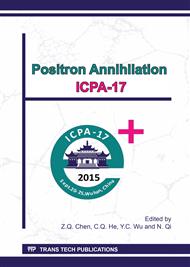p.17
p.23
p.31
p.35
p.41
p.46
p.53
p.57
p.61
First-Principles Calculation of Defect Formation and Positron Annihilation States in Bi2Te3
Abstract:
Defect formation energy in Bi2Te3 thermoelectric material was calculated using a first principles approach based on the Density Functional Theory (DFT). For vacancy-type defect, the Te1 vacancy (VTe1) is the most stable defect with low formation energy in both Bi-rich and Te-rich conditions, which indicates that the Te1 vacancies have higher probability to be formed. For antisite defects, the formation energy of BiTe1 is much lower than that of BiTe2 in Bi-rich condition, while in Te-rich condition it is beneficial for TeBi with lower formation energy. Positron wave function distribution and positron lifetimes of different annihilation states in Bi2Te3 were also calculated using the atomic superposition (ATSUP) method. The positron bulk lifetime in Bi2Te3 is about 231 ps, and for the neutral vacancy-type defects without relaxation, the positron lifetimes of VBi, VTe1 and VTe2 are 275 ps, 295 ps and 269 ps, respectively.
Info:
Periodical:
Pages:
41-45
Citation:
Online since:
March 2017
Authors:
Price:
Сopyright:
© 2016 Trans Tech Publications Ltd. All Rights Reserved
Share:
Citation:


